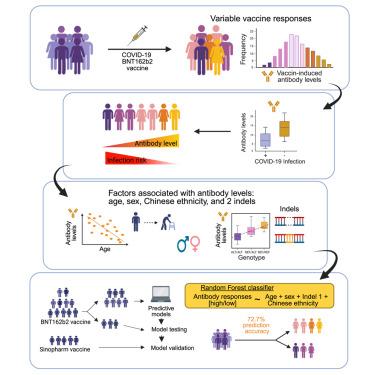Human indels as predictors of antibody responses to COVID-19 vaccines
IF 4.1
2区 综合性期刊
Q1 MULTIDISCIPLINARY SCIENCES
引用次数: 0
Abstract
Vaccine efficacy varies significantly among adults. This variability underlies the limitation of a one-size-fits-all vaccination strategy and the need for more personalized approaches. We investigated factors influencing inter-individual variability in antibody responses to COVID-19 mRNA vaccine among adults. Neutralizing antibody (nAb) levels after the first vaccine dose were associated with infection outcomes within 1 year after vaccination, suggesting their potential as a correlate of protection. Age, sex, and Chinese ethnicity were associated with nAb and anti-spike protein antibody levels. Two indels located at chr1:31433042 and chr15:76311269 showed significant association with antibody responses. Leveraging these host factors, we developed a Random Forest model that predicted vaccine-induced antibody responses with 72.7% accuracy for mRNA vaccine and 76.9% for the Sinopharm COVID-19 inactivated virus vaccine. These findings support predictive modeling as a tool to identify individuals at risk of low vaccine responses, enabling more targeted and effective vaccination strategies.

人类指数作为COVID-19疫苗抗体反应的预测因子
疫苗效力在成人中差别很大。这种可变性表明,一刀切的疫苗接种策略存在局限性,需要采取更加个性化的方法。我们研究了影响成人COVID-19 mRNA疫苗抗体反应的个体差异的因素。首次接种疫苗后的中和抗体(nAb)水平与接种后1年内的感染结果相关,表明它们可能与保护相关。年龄、性别和中国民族与nAb和抗刺突蛋白抗体水平相关。位于chr1:31433042和chr15:76311269的两个索引与抗体应答显著相关。利用这些宿主因素,我们建立了一个随机森林模型,预测疫苗诱导的抗体反应,mRNA疫苗的准确率为72.7%,国药集团COVID-19灭活疫苗的准确率为76.9%。这些发现支持将预测建模作为一种工具来识别疫苗反应低的个体,从而实现更有针对性和更有效的疫苗接种策略。
本文章由计算机程序翻译,如有差异,请以英文原文为准。
求助全文
约1分钟内获得全文
求助全文
来源期刊

iScience
Multidisciplinary-Multidisciplinary
CiteScore
7.20
自引率
1.70%
发文量
1972
审稿时长
6 weeks
期刊介绍:
Science has many big remaining questions. To address them, we will need to work collaboratively and across disciplines. The goal of iScience is to help fuel that type of interdisciplinary thinking. iScience is a new open-access journal from Cell Press that provides a platform for original research in the life, physical, and earth sciences. The primary criterion for publication in iScience is a significant contribution to a relevant field combined with robust results and underlying methodology. The advances appearing in iScience include both fundamental and applied investigations across this interdisciplinary range of topic areas. To support transparency in scientific investigation, we are happy to consider replication studies and papers that describe negative results.
We know you want your work to be published quickly and to be widely visible within your community and beyond. With the strong international reputation of Cell Press behind it, publication in iScience will help your work garner the attention and recognition it merits. Like all Cell Press journals, iScience prioritizes rapid publication. Our editorial team pays special attention to high-quality author service and to efficient, clear-cut decisions based on the information available within the manuscript. iScience taps into the expertise across Cell Press journals and selected partners to inform our editorial decisions and help publish your science in a timely and seamless way.
 求助内容:
求助内容: 应助结果提醒方式:
应助结果提醒方式:


